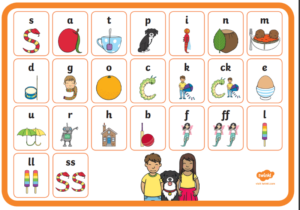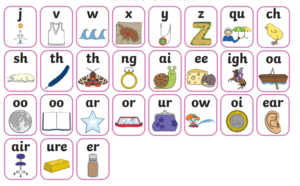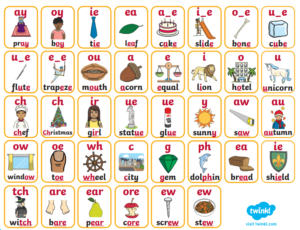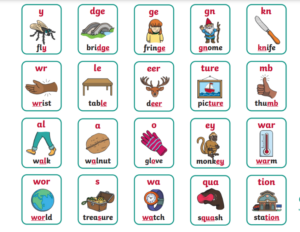Phonics

Phonics
Subject Leader: Mrs K Worgan
Our vision
At St. Joseph’s we believe that the teaching of high-quality, systematic phonics is the prime approach to reading and writing.
We enable children to start learning phonic knowledge and skills systematically, from when they arrive in Reception, with the expectation that they will be fluent readers having secured word recognition skills by the end of Key Stage One. We teach discrete daily sessions progressing from simple to more complex phonic knowledge and skills, covering the major grapheme/phoneme correspondences, and aim to fully prepare all children for the Year 1 phonics screening check. We follow a complete, systematic synthetic phonics programme. It ensures a structured approach to the teaching of grapheme-phoneme correspondences and the skills of blending and segmenting. Set pictures and actions help children remember each grapheme-phoneme correspondence. Lessons are direct, daily and interactive. Comprehensive lesson plans and resources are well organised and ensure consistency across classes. The programme helps us to ensure that phonics is used as the prime approach to reading and writing. We ensure that children have the opportunity to read texts and spell words that are appropriate for their stage of development in phonics.
Reception
Children begin their phonics learning journey during their settling in period. They work on embedding the Phase 1 skills (speaking and listening).
By the end of Phase 1 children will:
- have experienced a wealth of listening activities including songs, stories and rhymes;
- be able to distinguish between speech sounds and many will be able to blend and segment words
On the children’s first full day in Reception, they begin to work through the phonics programme, starting with Phase 2.

By the end of Phase 2 children will be able to:
- give the phoneme when shown any Phase 2 grapheme;
- find any Phase two grapheme, from a display, when given the phoneme;
- orally blend and segment CVC words;
- blend and segment in order to read and spell (this could be by using magnetic letters) VC words, such as if, am, on, up and nonsense words, such as ip, ug and ock;
- read the five tricky words – the, to, I, no, go.
After completion of Phase 2, the children move on to Phase 3, beginning to learn more complex grapheme-phoneme correspondences.

By the end of Phase 3 children will be able to:
- give the phoneme when shown all or most Phase 2 and Phase 3 graphemes;
- find all or most Phase 2 and Phase 3 graphemes, from a display, when given the phoneme;
- blend and read CVC words (single-syllable words consisting of Phase two and Phase three graphemes);
- segment and make a phonetically plausible attempt at spelling CVC words (single syllable words consisting of Phase 2 and Phase 3 graphemes);
- read the tricky words – he, she, we, me, be, was, my, you, her, they, all, are;
- spell the tricky words – the, to, I, no, go;
- write each letter correctly when following a model.
Following on from Phase 3, children move on to Phase 4.
By the end of Phase 4, children will be able to:
- give the phoneme when shown any Phase 2 and Phase 3 grapheme;
- find any Phase 2 and Phase 3 grapheme, from a display, when given the phoneme;
- be able to blend and read words containing adjacent consonants;
- be able to segment and spell words containing adjacent consonants;
- be able to read the tricky words – some, one, said, come, do, so, were, when, have, there, out, like, little, what;
- be able to spell the tricky words – he, she, we, me, be, was, my, you, her, they, all, are;
- write each letter, usually correctly.
Children are assessed at the end of each phase. Any children needing additional support with any of the phases, receive additional phonics input each day. Information from the summer assessments is passed on and discussed with the children’s Year 1 teachers.
In Year 1, children continue to work through the phonics programme. Any children needing continued work on Phases 2 – 4 receive a phonics input, in addition to the whole class phonics sessions.
Phase 5

By the end of Phase 5 children will be able to:
- give the phoneme when shown any grapheme that has been taught;
- for any given phoneme, write the common graphemes;
- apply phonics knowledge and skills as the prime approach to reading and spelling unfamiliar words that are not completely decodable;
- read and spell phonically decodable two-syllable and three-syllable words;
- read automatically all the words in the list of 100 high-frequency words;
- accurately spell most of the words in the list of 100 high-frequency words;
- form each letter correctly;
- Use alternative ways of pronouncing and representing the long vowel phonemes.
In the second half of the summer term, children in Year 1 take the Year 1 Phonics Screening Check. Year 1 teachers hold comprehensive transition meetings with the children’s Year 2 teachers, to pass on important information about next steps in the children’s learning journey.
Year 2
Children in Year 2 progress on to Phase 6 of the phonics programme. Children who did not meet the expected standard in the Year 1 Phonics Screening Check receive additional phonics input, based on their individual next steps.

By the end of Phase 6, children should be able to:
- read accurately most words of two or more syllables;
- read most words containing common suffixes;
- read most common exception words;
- read most words accurately, in age appropriate books, without overt sounding and blending, and sufficiently fluently to allow them to focus on their understanding rather than on decoding individual words;
- sound out most unfamiliar words accurately, without undue hesitation;
- segment spoken words into phonemes and represent these by graphemes, spelling many of these words correctly and making phonically-plausible attempts at others;
- spell most common exception words correctly.
At the end of Year 2, children who did not achieve the pass mark in the Year 1 Phonics Screening Check, will retake the check. All Year 2 children are assessed at key points during the year and information is passed on to their Year 3 teachers.
KS2
At St. Joseph’s, we believe that phonics should continue to be the prime approach to reading and spelling, as the children move up through the school. Staff throughout the school are trained in the teaching of phonics. Any children in KS2 needing support in any phases of the phonics programme, receive appropriate intervention.
Phonics Teaching
Mr Thorne Does Phonics: https://www.youtube.com/watch?v=LlTw0oiLNys
(How to learn the letters and sounds of the alphabet)
Reading schemes currently used in key stage 1 are:
Big Cat Collins, Oxford Reading Tree. Please see “Meet the Teacher” powerpoint for each year group for more details.


